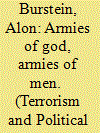| Srl | Item |
| 1 |
ID:
159881


|
|
|
|
|
| Summary/Abstract |
This article compares the violent activity of secular and religious terror organizations. Utilizing data compiled by the Global Terrorism Database cross-referenced with secondary and primary sources regarding the degree of religious components embedded in organizations’ ideologies, it tests the violent patterns of activity carried out by organizations guided by predominantly secular, secular/religious, and religious ideologies, between the years 1970 and 2012. The findings confirm that a) religious ideology correlates with specific, more deadly, attack tactics and violent patterns; and b) the degree of religious components within terror organizational ideology should be tested along a spectrum: the more religious an organization is, the more attacks it tends to carry out, and the deadlier its attacks become.
|
|
|
|
|
|
|
|
|
|
|
|
|
|
|
|
| 2 |
ID:
160527


|
|
|
|
|
| Summary/Abstract |
This article explores the ideological rigidity of secular and religious terror groups. Analyzing leaflets disseminated by two Palestinian groups during the First Intifada, it examines if and how each shifted its identity and goals in response to repression, political shifts, or resource changes. The results suggest that while similar catalysts led to ideological reformation among the secular and the religious group, the extent of ideological change within the religious group was more limited. The article argues for the need to disaggregate ideological analysis further in order to identify more subtle shifts, alterations, and omissions, in the positions held by religious terror groups, moving past the exploration of if such changes exist in ideological templates and instead focusing on the extent and type of alterations the different groups allow.
|
|
|
|
|
|
|
|
|
|
|
|
|
|
|
|